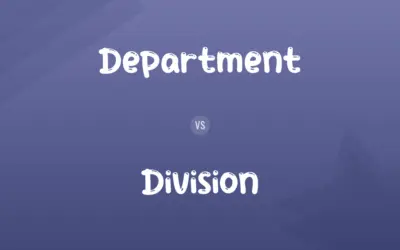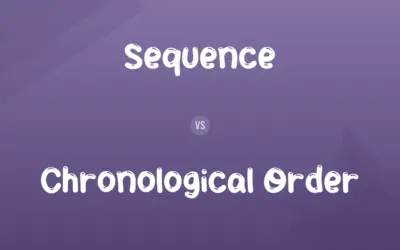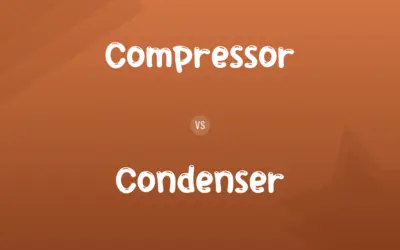Milling vs. Welding: Difference and Comparison
By Muazma Batool & Muneeza Rehman — Published on April 22, 2024
Milling involves removing material to shape and finish parts using a rotating cutting tool, focusing on precision and detailed cuts. Welding is a fabrication process that joins materials, metals or thermoplastics, by melting them together with heat.

Difference Between Milling and Welding
Milling is a machining process that utilizes rotary cutters to remove material from a workpiece. It's used to create parts with a wide range of shapes, slots, holes, and contours. Milling machines can perform many operations, from simple cuts to complex shapes and surfaces. The process is characterized by its ability to produce high-precision parts with excellent surface finishes. Welding involves the coalescence of materials by heating them to their melting point, often adding a filler material to form a strong joint. It's a fundamental technique for constructing and repairing metal structures and components. Welding can be performed using various energy sources, including gas flames, electric arcs, lasers, and electron beams.
Muazma Batool
Apr 22, 2024
The primary difference between milling and welding lies in their basic functions: milling is subtractive, removing material to create parts, while welding is additive, joining materials together. Milling is known for its precision and versatility in shaping parts, whereas welding is essential for assembling and repairing by fusing materials.
Muazma Batool
Apr 22, 2024
Milling requires detailed planning and setup, including selecting appropriate cutting tools and speeds, to achieve the desired shape and finish. Welding focuses on selecting the right welding method and materials (including filler metals and shielding gases) to ensure a strong and durable bond.
Muazma Batool
Apr 22, 2024
Both processes require skilled operators; however, the skills and knowledge base are quite distinct. Milling operators need to understand machining, tool selection, and programming for CNC (Computer Numerical Control) milling machines if used. Welders must be proficient in various welding techniques, metallurgy, and sometimes specialized equipment like TIG (Tungsten Inert Gas) or MIG (Metal Inert Gas) welding machines.
William
Apr 22, 2024
Milling vs. Welding Comparison Chart
Process Type
Subtractive manufacturing (removing material)
Additive manufacturing (joining materials)
Muazma Batool
Apr 22, 2024
Purpose
To shape or finish parts by cutting
To join materials by melting and fusing them together
Muazma Batool
Apr 22, 2024
Equipment
Milling machines, rotary cutters
Welding torches, arc welders, filler materials
Elijah
Apr 22, 2024
Application Fields
Automotive, aerospace, manufacturing
Construction, automotive, aerospace, manufacturing
Elijah
Apr 22, 2024
Skills Required
Knowledge of machining, tool selection, CNC programming
Proficiency in welding techniques, metallurgy
Elijah
Apr 22, 2024
Outcome
Precision parts with specific shapes and finishes
Strong joints and repaired structures
Muazma Batool
Apr 22, 2024
Key Considerations
Cutting tool type, material properties, cutting speed
Welding method, filler material, shielding gas
Olivia
Apr 22, 2024
Milling vs. Welding Definitions
◉Milling
Can produce detailed and smooth finishes.
Milling provided the precise dimensions needed for the aerospace part.
Muazma Batool
Feb 21, 2024
◉Welding
Provides structural strength to assemblies.
Welding ensured the durability of the automotive chassis.
William
Feb 21, 2024
◉Milling
Involves rotary cutters to remove material.
The craftsman used milling to achieve the intricate design of the jewelry.
Kaitlyn
Feb 21, 2024
◉Welding
Joins metal parts by melting them together.
Welding was used to assemble the steel framework of the building.
Muazma Batool
Feb 21, 2024
◉Milling
Used for slots, threading, and contours.
The machine shop performed milling to create the custom gears.
Muazma Batool
Feb 21, 2024
◉Welding
Utilizes heat and filler materials for joining.
The artist used welding to fuse the metal sculptures.
Muazma Batool
Feb 21, 2024
◉Milling
Essential for precision manufacturing.
The milling process was critical in producing the high-precision medical devices.
Muazma Batool
Feb 21, 2024
◉Welding
Employed in repairing metal structures.
The damaged pipeline was restored using advanced welding techniques.
Muazma Batool
Feb 21, 2024
◉Milling
A precision cutting process to shape metal parts.
Milling was used to create the complex components of the engine.
Muazma Batool
Feb 21, 2024
◉Welding
Critical in construction and manufacturing.
Welding techniques were key in constructing the bridge.
Elijah
Feb 21, 2024
◉Milling
The act or process of grinding, especially grinding grain into flour or meal.
Muazma Batool
Feb 20, 2024
◉Welding
To join (metals) by applying heat, sometimes with pressure and sometimes with an intermediate or filler metal having a high melting point.
Muazma Batool
Feb 20, 2024
◉Milling
The operation of cutting, shaping, finishing, or working products manufactured in a mill.
Muazma Batool
Feb 20, 2024
Milling vs. Welding Frequently Asked Questions
What safety precautions are necessary for milling and welding?
Both processes require safety precautions: milling involves wearing protective eyewear and using guards to protect against flying chips, while welding requires protective gear including helmets, gloves, and proper ventilation to guard against heat, sparks, and harmful fumes.
Muazma Batool
Apr 22, 2024
Can milling and welding be used together?
Yes, in many manufacturing processes, milling is used to create parts with precise dimensions, and welding is then used to join these parts together.
Muazma Batool
Apr 22, 2024
What factors influence the choice between milling and welding in a project?
The choice depends on the project's requirements: milling is selected for creating precise components and details, while welding is chosen for assembling or repairing parts. The decision is influenced by the desired outcome, material type, and structural needs.
Levi
Apr 22, 2024
Are milling and welding limited to metal materials?
Milling can be performed on metals, plastics, and composites, while welding is primarily used with metals and thermoplastics.
Muazma Batool
Apr 22, 2024
How do material properties affect milling and welding?
Material properties significantly impact both processes; in milling, the material's hardness and machinability dictate the cutting speed and tool choice. In welding, the material's melting point, thermal conductivity, and expansion rate influence the welding technique and filler material selection.
Muazma Batool
Apr 22, 2024
Which process is better for creating custom parts?
Milling is typically better for creating custom parts with precise dimensions, while welding is essential for assembling or repairing parts.
Muazma Batool
Apr 22, 2024
What advancements have been made in milling and welding technologies?
Advancements in milling include high-speed machining, 5-axis CNC milling, and the use of more durable cutting materials. In welding, developments include laser welding, friction stir welding, and automated robotic welding, offering improved precision, efficiency, and strength.
Muazma Batool
Apr 22, 2024
Is CNC technology applicable to both milling and welding?
CNC technology is widely used in milling to control machine tools precisely. For welding, CNC technology is less common but can be used in automated welding processes.
Muazma Batool
Apr 22, 2024
How do environmental factors impact welding?
Environmental factors, such as wind, humidity, and temperature, can significantly affect welding, especially outdoor welding. Wind can disperse shielding gas, humidity can introduce moisture and affect weld quality, and extreme temperatures can influence metal expansion and cooling rates.
Elijah
Apr 22, 2024
How does the complexity of a part affect its manufacturing process?
Complex parts with intricate shapes or requiring high precision are often milled to achieve the necessary specifications. Welding is used to join complex assemblies or add structural strength, depending on the project's complexity and requirements.
Muazma Batool
Apr 22, 2024
Content Creators
Written by
Muazma BatoolAs a content editor, Muazma Batool is not just a grammar guru but a creative mastermind who breathes life into every word. With an eagle eye for detail and a passion for storytelling, she transforms bland text into engaging content that captivates audiences and drives results.
Co-written by
Muneeza RehmanAt Comparisons.wiki, Muneeza skillfully navigates the vast sea of information, ensuring clarity and accuracy as the lead content editor. With a keen eye for detail, she curates every comparison to enlighten and engage readers.

































